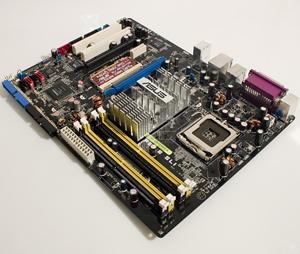Asus P5N-E SLI Nvidia nForce 650i SLI
Board Layout
Board Layout
The Asus P5N-E SLI uses a fairly standard design based on an ATX form factor and a sleek black PCB. Asus didn't take any huge chances with the design here, but considering this board is targeted at the mid-range market, they didn't really have to. Notable items upon first glance are the dual PCI Express x16 sized slots with SLI link adapter, the huge heatsink passively cooling the Northbridge, and a Southbridge which is not cooled by anything.

Asus P5N-E - Top Focused |

Asus P5N-E - Bottom Focused |
Starting off at the top of the board, we have support for Socket-775 processors. The board is designed with the Core 2 in mind, so Core 2 Duo and Quad processors are supported right out of the box. The board also supports older Pentium and Celeron processors as well, if you want to take that route. While Nvidia states that the nForce 650i SLI chipset only supports front side bus speeds up to 1066 MHz, Asus goes a bit further and gives official support for 1333 MHz FSB processors on their product pages and in the manual. As Nvidia's high-end 680i chipset (which the 650i is based on) supports 1333 MHz+ FSB processors, seeing this feature on the 650i isn't too shocking. In our testing, we found that this 650i board can go well beyond 1333 MHz FSB, so this board is certainly in the clear for Intel's next-generation 1333 MHz FSB Core 2 based products which are scheduled to hit later this year.
There are a number of onboard components which are a little too close to the CPU socket for comfort. In particular, there are capacitors to the top and left of the socket which may interfere with some coolers. One of the coolers we used on this board actually pushed down on these capacitors and was barely able to make contact with the processor, which is certainly not a good thing. Intel's stock cooler, however, is a perfect match for this board. The overly large passive Northbridge cooler is also pretty close to the CPU socket, and the height of this unit also may interfere with some coolers.
Asus leaves the processor VRM modules around the CPU socket free of cooling, which may hinder heavy overclocking, as these get quite hot under heavy loads. Similar boards from Asus typically have heatpipes and/or heatsinks covering these components, so seeing a board suddenly without any cooling at all on these components leaves us somewhat weary. However, throughout testing, we did not run into stability issues due to overheating VRM's - not to our knowledge, anyway.

CPU Socket |

Northbridge Cooler |
The nForce 650i Northbridge is covered by a massive aluminum alloy heatsink which sits in between the CPU socket and primary PCI Express graphics slot. The nForce 650i generates considerably less heat compared to the high-end 680i chipset, which typically needs copper heatpipes and/or fans in order to be cooled properly. The 650i, however, is perfectly happy being cooled passively, although this heatsink does run quite hot under normal loads. The heatsink is connected to the 650i Northbridge via a pre-applied layer of thermal paste. It's highly recommended that users of this motherboard have airflow coming from both the CPU cooler and from a rear exhaust fan in order to keep the chipset cool. On the plus side, with just a big heatsink cooling the board, it runs absolutely silent by default, even without the use of expensive heatpipes. In addition, the Nvidia Southbridge chip runs bare, free from any kind of cooling. This chip also runs slightly warm, but not hot enough to require dedicated cooling. Asus does leave mounting holes, however, should you want to apply your own third party chipset cooler. The Northbridge cooler also uses standardized mounting holes, so it's possible to remove the large aluminum alloy cooler to apply a different cooler on this chip as well.
The P5N-E SLI is equipped with 4 x DDR2 DIMM slots, capable of speeds up to 800 MHz. Unlike the high-end 680i SLI chipset, the 650i does not officially support DDR2 speeds of 1066 and 1200 MHz, nor does it officially support EPP memory modules. We have seen in newer BIOS revisions from Asus that EPP modules are supported, although we did not have the opportunity to test a large number of DDR2 modules beyond 800 MHz in order to test the flexibility of the board here. Interestingly enough, we found in testing that the board had a tendency to be more stable when using the "black" DDR2 slots on the board rather than the yellow slots, which is what Asus recommends if you're only using 2 x DDR2 modules. In terms of memory support, the board seems a bit quirky at this time, but when modules were placed in the black slots, we had no problem getting them to run at their fastest 4-4-4-12 timings and retaining full stability.






